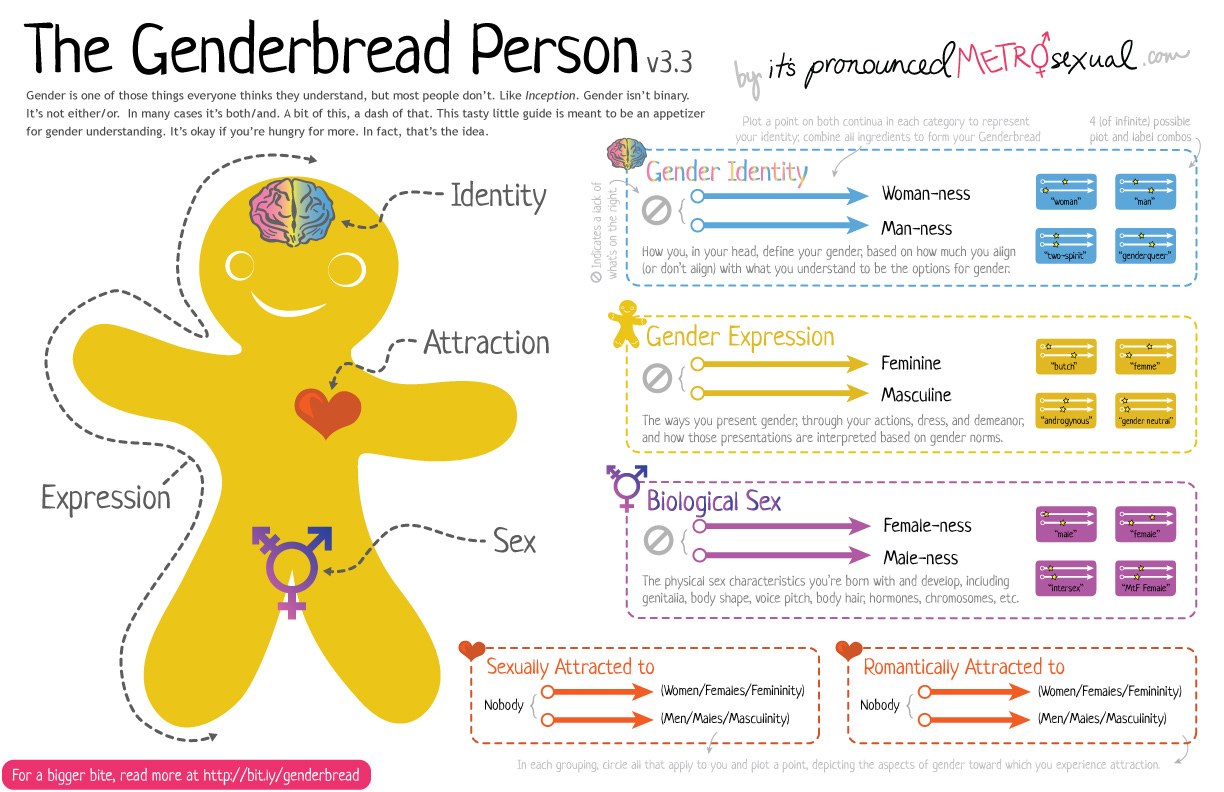Gender Identity Discrimination
Gender Identity Discrimination is the act of prejudice against transgender or non-conforming gendered persons based on their gender choices and outward gender expression. This includes harassment both physically and verbally, often occuring in workplace and schooling environments. It is also seen in situations such as renting an apartment, shopping, going to restaurants, health care, cases of law enforcement and other non specific moments[1]. This treatment is not focused on one specific age grouping or race, affecting all groups of people around the world, even in countries where it is not illegal to be transgendered.
Gender Identity Vs Gender Expression
Sex is the anatomical genes that a person is born with. These are embedded in our chromosomes and are unchangable.
Gender Identity is the internal and individual experience of gender[1].
Gender Expression is the outward expressed and performed sex (or lack thereof) that an individual identifies with. This ranges from male to female in a spectrum, and can exist outside of it as well.
Effects and Impacts
Gender Identity discrimination has many short and long term lasting effects on individuals affected by it. Immediate problems such as the inability to find work, places to stay, appropriate healthcare professionals trained to deal with transgendered individuals, and other related issues are some of the most common. Some individuals who are seen as "passing" as the gender they identify with but are not physically alligned with can experience even further stress if they are outed or willingly come out to their companies or colleagues, and are not accepted. This can result in more lasting effects, such as mental instability on the levels of depression, gender dysphoria, PTSD, and other psychological disorders. Some individuals also report earning less than their non-transgendered coworkers, and individuals of colour also received additional discrimination from employers and coworkers[2].
Legislation and Lawsuits
The United States of America alone, several large court cases have gone through such as Smith v. Salem and Price v. Waterhouse, where individuals have gone to court over workplace issues surrounding their gender expression[3] Since these and other cases, several American states have moved forward to put in place statues that limit discrimination in employment based on gender identity and expression in an effort to curb future disputes[4]. Unfortunately, there are no universal federal laws in America to protect LGBT+ workers, only widescale discrimination laws that blanket other topics of discrimination such as racial or religious bias[5]. There are also laws protecting against sexual orientation discrimination, but this is targeted towards the sexuality of an individual, such as heterosexuality or homosexuality[5]. Many individuals receiving harrassment in states where transgendered individuals aren't protected by law are forced to try and argue their cases under the clause of sexual harrassment, as it is the closest possible way to receive protection against workplace incidents[5]. Companies are also not allowed to deny individuals employment on a religious moral ground, as it falls under a similar catagory to rejecting individuals like homosexuals for their sexual choices[5]. Rules regarding the ability for an individual to dress as the gender they identify with at work are work-place specific, and legislation cannot fully protect an individual who wishes to argue over their choice of uniform, often needing to take these claims to private complaints with attourneys.
Canada's Position on Gender Identity Discrimination
In Ontario, transgendered protection rights started in 1999, when the Human Rights Council announced that transgendered people should be free from harrassment and discrimination[1]. Gender Identity and expression were added to the Human Rights Code in 2012[1]. During a collection of statistics by a group called TransPULSE, it was reported "3% of trans people have been made fun of, 39% have been turned down for a job, 26% have been assaulted, and 24% have even been harassed by police." [6]
British Columbia held a series of Human Rights Tribunals in 1999 that defined discrimination against an individual due to their gender identity as being sex discrimination[6].
Saskatchewan, Alberta, Yukon, Prince Edward Island, Quebec and New Brunswick have filed similar human rights guides labeling gender identity discrimination as a form of sex discrimination[6].
In 2016, new legislation was introduced by the Government of Canada to help better define and protect Gender Identity and Expression, trying to block out discrimination, propaganda and hate crimes[7]. It includes reforms to the Canadian Human Rights Act, and the Criminal Code that add gender identity and expression to the existing lists of identifiable groups that are often targets[7].
References
- ↑ 1.0 1.1 1.2 1.3 Commission, Ontario Human Rights. Policy on Preventing Discrimination because of Gender Identity and Gender Expression. Ontario Human Rights Commission, 2014.
- ↑ Badgett, M.V. Lee; Lau, Holning; Sears, Brad; & Ho, Deborah. (2007). Bias in the Workplace: Consistent Evidence of Sexual Orientation and Gender Identity Discrimination. The Williams Institute. UCLA: The Williams Institute.
- ↑ Edward, C. Gender Identity Discrimination in Employment: Analysis of H.R. 3686 in the 110th Congress (RL34242).
- ↑ Jefferson, Courtney J. University of Baltimore Law Review: Gender Confusion: The Need for Effective Legislation to Protect Against Gender Identity Discrimination. 39 Vol. University of Baltimore School of Law, 09/22/2009.
- ↑ 5.0 5.1 5.2 5.3 http://www.workplacefairness.org/gender-identity-discrimination#3
- ↑ 6.0 6.1 6.2 http://egale.ca/faq-gender-identity/
- ↑ 7.0 7.1 http://www.justice.gc.ca/eng/cj-jp/identity-identite/index.html
